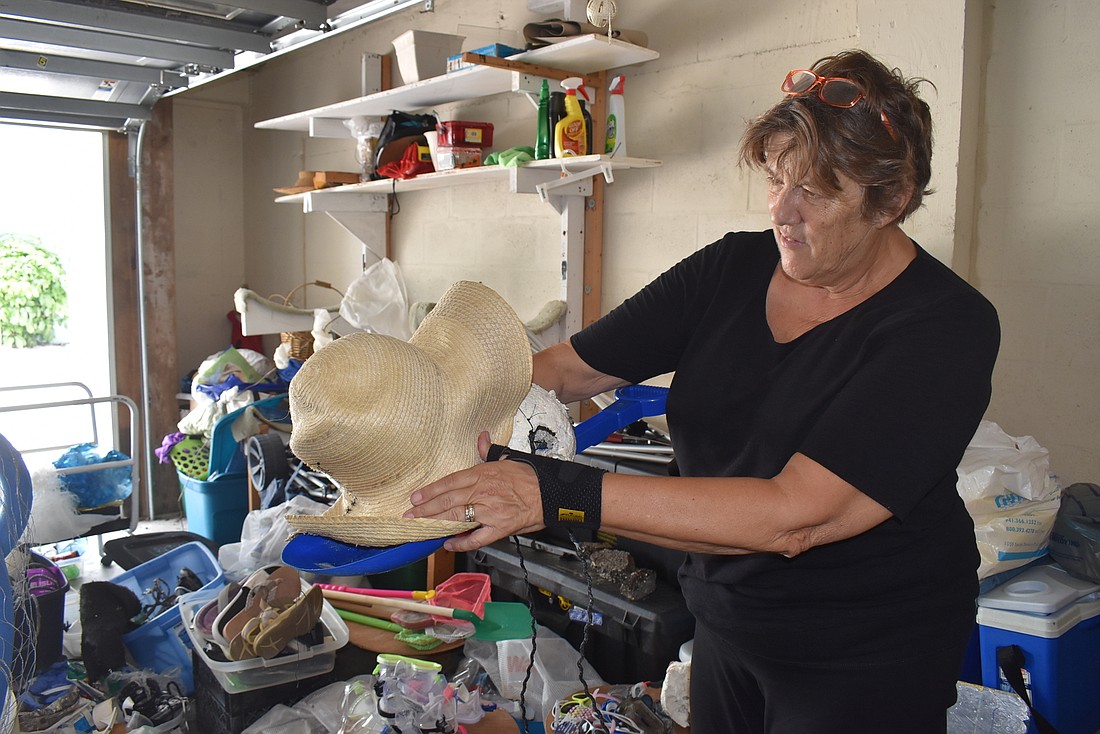- December 20, 2025
-
-
Loading

Loading

Wendell Graham is unafraid of getting a little trashy.
OK, maybe a lot trashy. Her garage is half-taken over by buckets of beach trash — sunglasses, goggles, boogie boards, shoes, and enough plastic water bottles to last you through hurricane season. It’s all come from Longboat Key’s beaches, courtesy of the Longboat Key Turtle Watch.
Graham once went out on an early-morning turtle walk with Mike Herron, shadowing the experienced patroller. When turtle watchers go out, they always pick up the trash they see on the beaches along their routes, and that day, Graham and Herron saw folks coming in with their haul of trash for the day.
“We're just disgusted with and saddened at how people can leave this on the beach,” Graham said. “They [LBKTW] said, ‘We wish we could find an artist, we need to find an artist or something to do something with this trash to bring awareness.’
“I didn't say anything for a second. And I said to them, ‘I'm an artist, I can do a sculpture for you.’”
And so it began. The trash is clean, of course. Graham had to develop a process for getting sand-and-salt covered refuse clean enough to work with (though sand stills cascades out of bottles and cans) after the turtle watch members brought over another load of “materials.”
“I would get it, bring it back here, fill it, rinse it off, fill it in a different bucket with bleach, let it sit for a few days, disinfect it, rinse it off again, do all that then get it sorted,” Graham said.
As she started sorting, she started noticing things, like how a painter would suddenly find the perfect color. A wrinkled old towel Graham deemed “marvelous” would serve as the perfect textured neck for the loggerhead. A pair of foam fishing bobbers jumped out as the perfect eyeballs, she said while holding them in front of her eyes.
“One of the things that surprised me the most about this project is how many children's toys there were,” Graham said. “Because people will just ditch them on the beach, they just leave them.”
Graham has plenty of toys in her arsenal, including shovels both big and small, whole boogie boards, diving toys and a whole box of snorkel masks. One shovel will become the lower part of the jaw and the turtle’s “neck,” a boogie board is currently supporting the middle of the body structure, and the snorkel masks will get cut in half and used as scutes, which are the segmented ridges on the turtle’s shell.
The artist didn’t know much about turtles before embarking on this project, but with the help of turtle watchers Mike and Melissa Herron, she knows a bit more about scutes, plastrons, head and tail shapes and the like. In one corner of her garage workspace, a desk is covered in papers, diagrams, sketches and various adhesive materials for research.
That education and the spirit of learning and getting better motivates Graham for the project. She also has a blog where she posts updates on the project, educate herself and those who follow her. Graham wants to get it right, and she wants people to realize what has happened and take steps to fix it. It’s not about scolding people and telling them they’re outright bad people. It’s about changing behavior.
“We have a problem. So together, let's solve it,” said Graham. “But if a child sees it, in my plan to see the plants a seed about the environment, and plants a seed about being an artist, it plants a seed about doing something. So it does a lot of good in many ways. And the main way right now is to bring awareness to the turtles and the trash and our environment.”
There are other artists working with trash, including Angela Haseltine Pozzi, who has a team of volunteers and staff finding and sorting immense amounts of trash by color. This volume and variety results in brilliantly colored sculptures in shades of red for an octopus, or blue for a whale. It gives it a “pretty factor,” Graham said.
“This is trash, recycled trash. This is dirt,” Graham said. “This is going to look like a recycle trash turtle.”
The massive turtle will be displayed at the Longboat Key Turtle Watch’s meeting in early November, and Graham hopes to have it done by Oct. 31. And it won’t be just the turtle, but a scene surrounding it, as well. Graham wants to have the turtle on an angle, swimming up towards a “jellyfish.”
“I think that if this were blown up, doesn't it look like a jellyfish?” Graham said, holding up a frayed tarp bag. “And that's what they think is food. So they eat that, then they can't digest it. It breaks your heart.”
The sculpture goes along well with Graham’s portfolio, which includes other pieces made of found objects and paintings in which she allows the paint to move around, finding the real subject of the piece later, when it appears. However, her reputation as an artist isn’t really what got her into this project. Above all, it’s to bring awareness to what trash thrown on the beach can do, and how quickly it builds up.
“People, I don't think, intentionally do things to harm anybody else,” Graham said. “But I feel that our actions all of us know that there's not one person that can say that they haven't accidentally done something, you know.”
In this case, trash has become art, but Graham wants it to become more than art — a message.
“So trash is not just trash. It involves all of us,” Graham said. “It's very important that we all work together because turtles are part of our environment. And if something happens to them, it's going to happen to all of us.”